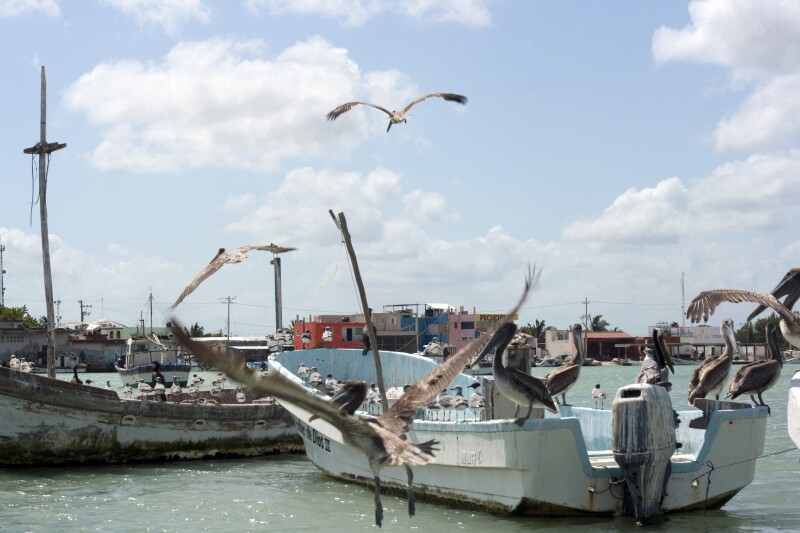Río Lagartos is one of those hidden gems that you hope stays hidden. Located along an inlet from the Gulf of Mexico in the Yucatán Peninsula, this vibrant fishing town is the sort of place where everyone knows each other’s name. Doors are painted Caribbean-blue and walls are lemon-yellow, and kitsch pink flamingos line the gates of the quaint one-story houses. But that’s what Río Lagartos is known for.
Instead, Río Lagartos is known for the thousands of flamingos that nest in the waters of this coastal inlet during the month of April. Although watching these bold, Yucatán flamingos prance along the silty water of Ría Lagartos (ría refers to the body of water, Río to the town) is well-worth the day trip from the Riviera Maya, there’s something even more remarkable a few kilometers away—the pink waters of la Playa de las Coloradas.

Yes, pink waters.
unknown
La Playa de las Coloradas is a bright-pink salt lake in between Ría Lagartos and the Gulf of Mexico. In the mornings, these natural salt marshes appear to be merely tinged with coral hues, but as the sun heats up in the afternoon, they radiate hot-pink tones.
But the area’s pink hue isn’t just any pink, it’s a pink unique to the area, found in varying concentrations throughout the salt marshes and on the flamingos. This Yucatán pink is the work of one animal in particular—the artemia salina, a crustacean best described as something between shrimp and lobster. Because the artemia salina absorbs the pigment of its prey—in this case, the pink microorganisms that live such salty water—its body also turns a shade of pink. When the flamingos come to feed on the artemia salina, they too take on this same pink.
However, Río Lagartos isn’t only pink flamingos and salt lakes. In fact, the the area is a protected biosphere and home to over 350 species of birds alone, not to mention mounds of mangroves, crocodiles, and corbina fish. The lagartos, or crocodiles for which the area was named, can easily be seen lurking in the shallow waters among the mangroves while local fisherman go after their daily catch of corbina. Even if you don’t have the slightest inclination towards nature, Ría Lagartos is a good place to start developing one.

Just a few of the many birds of Río Lagartos
unknown
What to do
- Go for the tour. It is possible to reach La Playa de las Coloradas by car, but you won’t be seeing any flamingos or much wildlife without a speedboat. Choose a tour from one of the authorized tour guide booths located on the town’s boardwalk. Most tours accommodate up to six people.
- Float in Las Coloradas. After you’ve recovered from the shock of pink water, go for a float. The high salt content of the marshes at La Playa de Las Coloradas makes you extra buoyant.
- Take a baño maya. While it’s not really a bath, the baño maya refers to a clay mask high in sulfur found on the banks of the inlet. Many tour guides encourage their groups to cover themselves in the clay, as its minerals treat many different skin conditions.
- Actually touch a crocodile. According to the guides who spend their lives interacting with the area’s many creatures, the crocodiles of Ría Lagartos are tranquilos, or calm. They say the crocodiles are actually more scared of the speedboat motors than anything. See how close you can get and give a little pet to that prized skin of theirs.
- Stroll along the boardwalk and roam through the town. Although the biosphere is the main attraction, the town has a certain charm. It’s a quintessential Yucatán fishing village and worth a wander.
- Eat fresh-caught corbina from the ría. Stop for lunch at one of the restaurants on the boardwalk and order a pescado empanizado, fried fish, or a pescado al mojo de ajo, fish in a garlic sauce. Both La Torreja and El Perico are good options with views of the water.

On the road in Río Lagartos
unknown
How to get there
No one said it would be easy. Though really, getting to Río Lagartos is more taxing than it is difficult. Long story short—rent a car.
The municipality of Río Lagartos is located about 3 hours from any of the main towns on the Riviera Maya—Cancun, Playa del Carmen, and Tulum. It’s about the same distance from Merida, a major city in the Mexican state of Yucatán. Make sure to have a good playlist before you leave, as the initial stretch of highway from Cancun en route to Río Lagartos feels so endlessly straight that after the first hour it can get nerve-racking.
Don’t forget to stop along the way and let the journey be half the fun. The route gets interesting when you reach the town of Valladolid. Take in its colonial Spanish architecture or pick up some handmade indigenous clothing in the center of town. As you head north from Valladolid, the drive through the Yucatán countryside becomes quite scenic, especially after Tizimin. And for the ultimate road trip rest stop, there’s cenote Kikil, a freshwater pool on the outskirts of Tizimin, if you want to take a dip.











